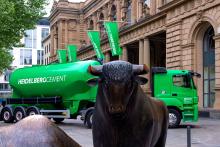
German building materials group
Group revenue rose 7% to €9.2 billion on a like-for-like basis compared to H1 2018, but profit for the period stood at €291 million, compared to €435mn the previous year.
“Despite a persistently challenging environment, we increased our revenue in the first half of 2019,” said Dr. Bernd Scheifele, chairman of the HeidelbergCement managing board. “In general, the market dynamics weakened slightly in the second quarter in comparison with the first quarter. Good margins in Asia as well as Western and Southern Europe more than compensated for the weaker business due to adverse weather conditions in North America and the Africa-Eastern Mediterranean Basin Group area.”
In the first half of 2019, HeidelbergCement made further progress in optimising its portfolio with the conclusion of several important transactions. These include increases in its shareholdings to 100% in California Commercial Asphalt in the USA and in Nordic Precast Group in Northern Europe, from 50% and 60% respectively, and the acquisition of the aggregates and ready-mixed concrete activities of
Overall, cash-relevant maintenance and growth investments, including the increase in ownership interests in subsidiaries, fell to €590 million (previous year: €992mn) in the first half of the year. Cash-relevant divestments, including the decrease in ownership interests in subsidiaries, amounted to €290 million (previous year: €294mn).
HeidelbergCement is consistently pursuing its action plan to accelerate the optimisation of its portfolio and is on track to achieve its disposal target of €500 million in the 2019 financial year. On 1 July 2019, the sale of the Testi cement plant and of two grinding plants was completed in Italy.
At the end of H1 2019, HeidelbergCement has around 57,300 employees (59,600 at end of H1 2018). The decrease of around 2,300 employees essentially results from two opposing developments. On the one hand, around 3,200 jobs were cut across the Group as a result of portfolio optimisations, the realisation of synergies, efficiency increases in sales and administration, as well as location optimisations. On the other hand, around 900 new employees joined the Group as a result of first-time consolidations in North America and Australia as well as new hires in some countries in the Western and Southern Europe and Northern and Eastern Europe-Central Asia Group areas.
On 24 July 2019, HeidelbergCement published its Sustainability Report for the 2018 financial year. In view of its ambitious emission reduction targets, HeidelbergCement is setting clear priorities when it comes to climate protection. By 2030, the company has committed itself to the goal of decreasing its specific net CO2 emissions per tonne of cement by 30% compared with 1990. HeidelbergCement intends to realise its vision of CO2-neutral concrete by 2050 at the latest.
Besides climate protection goals, the report documents the company’s CSR activities in areas such as human rights and compliance, occupational health and safety, supply chain and supplier management, research and development, biodiversity, as well as sustainable land use and water conservation.
HeidelbergCement expects that favourable energy costs in comparison with the previous year as well as the solid development in Europe, North America, and Asia, especially in Indonesia, will contribute positively to full 2019 year trading performance.
In view of these expectations, the overall positive economic development, and the solid first half of the year, HeidelbergCement anticipates a rise in sales volumes for the core products of cement, aggregates, and ready-mixed concrete, and continues to assume that in 2019, revenue, result from current operations before IFRS 16, exchange rate and consolidation effects, and the profit for the financial year before non-recurring effects will increase moderately (+3% to +9%).
“We are confident about the second half of the year,” remarked Dr. Scheifele. “We are continuing to focus on our action plan to accelerate the portfolio optimisation and increase our margins as well as cash flow.”





